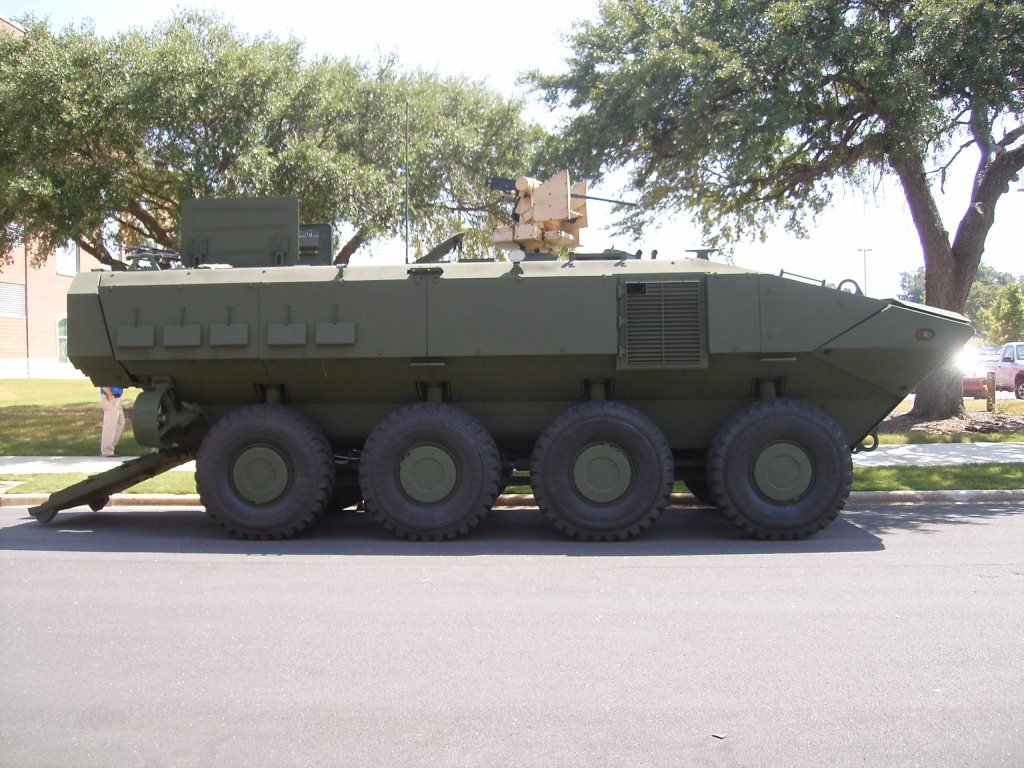 ACV at 2013 Maneuver Conference Photo by Will Rodriguez
ACV at 2013 Maneuver Conference Photo by Will Rodriguez The Marines were defending their number one modernization priority in front of the Senate Armed Services Committee’s Subcomittee on Seapower this week. A “new” wheeled amphibious vehicle called the Amphibious Combat Vehicle (ACV) is slated to replace the majority of the Corps 40 year old AAV-7 Amphibious Assault Vehicle. GruntsandCo’s covered the ACV in its 2013 Maneuver Conference coverage. It was called the Marine Personnel Carrier (MPC) back then. The backstory of the Corps’ confusing name switching was covered in Breaking Defense.
The Corps desperately needs to replace the AAV-7. It lacks mobility to keep up with M1 tanks, armor protection and is over 40 years old. The first two shortcomings were readily apparent in the initial race to Baghdad and subsequent combat in Iraq. The previous attempt to replace the AAV-7 was the Expeditionary Fighting Vehicle (EFV). The EFV concept featured a tracked vehicle powerful enough to plane above waves allowing the Marines to land on a beach from positions beyond the horizon providing distance to the warships launching them. The program failed terribly because of its technical complexity, cost and over 25 year program development. Subsequently it was cancelled in 20111 and the Marines have been scrambling since to replace the AAV.
The recent discussion in DC largely revolved around the classic debate around selecting wheeled vs. tracked armored vehicles. Wheeled armored vehicles tend to be faster on roads and cheaper to procure and maintain compared to tracked vehicles. Tracked vehicles permit heavier armor protection, increased mobility in varied terrain but at greater acquisition and maintenance costs. The issue is further complicated because of the Marines amphibious requirement to support their core competency, landing on enemy coasts. That requirement adds cost to any solution and also limits the number of possible already existing solutions. There are just not that many amphibious vehicles that can handle the conditions one must expect in a sea environment vs. an inland waterway.
The Marines are looking at fielding a mixed force of vehicles to provide amphibious armored mobility to 10 battalions of infantry. A little less than 400 of the existing 1,062 tracked AAV’s will get armor upgrades to improve survivability and provide a more robust forced entry capability for four Marine infantry battalions. The rest of the requirement of about 600 vehicles will hopefully be serviced by acquiring the wheeled ACV.
The ACV can handle a sea state 2, an ocean condition featuring waves of almost two feet and in its current configuration ACV 1.1, carries 10 Marines. Marine Infantry squads consist of 13 men. Future versions, the ACV 1.2 are hoped to carry 12-13 Marines. The ACV is based on the Finnish Patria Armored Modular Vehicle (AMV)but is also slated to incorporate the double “V” hull featured in the Army’s latest version of the Stryker to provide better IED protection.
The Corps needs to be especially careful to avoid the Army’s mistake of accepting the Bradley at the cost of it not being able to carry a full 9 man squad, splitting the squad across multiple vehicles. The Army relearned trying to link up squad elements under fire is incredibly difficult as is employing a unit with cross attached squads in multiple vehicles. Sending a squad off on a mission not only required multiple vehicles (not always a bad thing) but often stripped a second squad of some of its manpower complicating the platoon’s ability to execute other missions. For instance, a platoon tasked to immediately chop a squad to an armor platoon for local security or to establish a checkpoint had to send a squad and a half and two of its four vehicles to execute the mission. This left the mechanized infantry platoon with half its vehicles and a half to 1.5 squads left to do other missions. (Early Bradley platoons only had two squads of Infantry. Later seating reconfigurations increased the mechanized platoon to three 9 man squads).
Since the Bradley was initially fielded, the Army’s experience in Iraq and with the Stryker fielding, the Army rediscovered the basic truth that an Infantry squad needs to be organic to one vehicle. The importance of the lesson is demonstrated in the Army’s non-negotiable requirement that both the Ground Combat Vehicle (recently cancelled Bradley replacement) and ULCV carry a full 9 man infantry squad.
I wish the Marines luck. The new amphibious vehicle has to be able to transit the sea from its launching ship to the beach. It needs to keep up with the M1 tank even at the cost of armor protection. The ACV can be armored to defeat up to 30mm fire across the frontal arc. It has to be affordable and available in the near term. Finally, the vehicle needs to carry a full 13 man Marine Infantry squad. The Corps needs a new amphibious vehicle badly.
